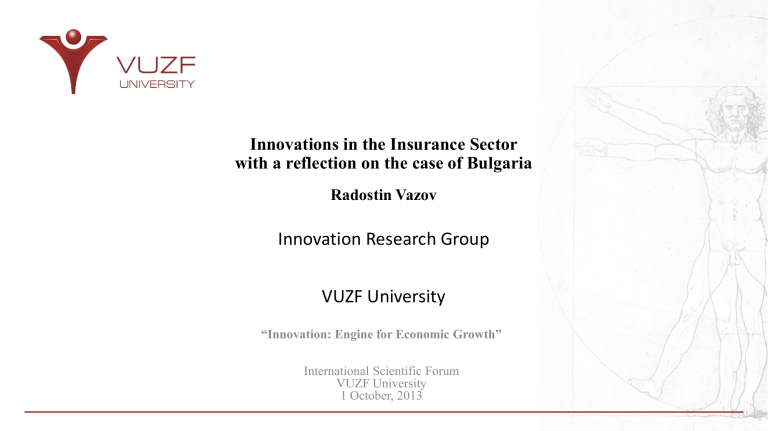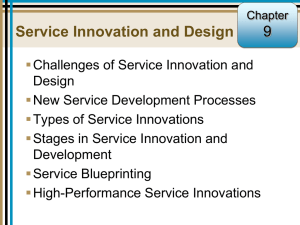Innovation: Engine for Economic Growth

Innovations in the Insurance Sector with a reflection on the case of Bulgaria
Radostin Vazov
Innovation Research Group
VUZF University
“Innovation: Engine for Economic Growth”
International Scientific Forum
VUZF University
1 October, 2013
The worst innovation for the last 10 years
It may be hard to remember how innovative ideas like credit default swaps (CDS) and similar derivatives were expected to increase profits and lead to a new world of low-risk investments and continued economic growth.
That didn’t work out as expected, and innovation sometimes doesn’t.
The question then becomes whether it is worth the risk?
Most corporate executives recognize the value of innovation, but few would be brave enough to boast of clearly understanding the process of implementing innovation in a business model, and even fewer of successfully integrating continuous cycles of innovation in their own companies.
INNOVATION
Relative frequency of mentions of the word innovation in books cataloged by Google books
WHAT IS INNOVATION?
“Trade-offs define the limit of what is possible at a point in time, not what is possible for all time … all innovation is about breaking tradeoffs.”
Michael Raynor, ” The Innovator’s Manifesto”
Вreaking trade-offs through innovation allows a company to reach a point in “strategic space” that competitors cannot, allowing a company to provide a product at a price or performance level competitors cannot match, Raynor argues.
Professor Kim B. Clark argues that there are three types of innovations:
• Empowering
• Sustaining
• Efficiency
Counter argument:
• In the words of the old cliché, innovation and insurance are found together only in the dictionary.
• the conservative reputation the industry enjoys has served to camouflage a tremendous track record of innovation
Top 10 Most Innovative P/C Insurance Products and its impact on Bulgaria
• Pay-As-You-Park:
Private passenger auto policy from Progresso. Rates are based on how long the vehicle is not driven.
• GreenMaker:
R.W. Barkley is selling a product liability policy for home or garagebased businesses that manufacture cosmetics, clothing, jewelry, toys, computers, beer, firearms, scuba gear, musical instruments, motor vehicles, mobile homes or other products using primarily recycled, upcycled, natural or organic materials.
• Commercial Specific Liability (CSL):
A low-cost option to the Commercial General Liability (CGL), the CSL lets business owners specify the exposures they want covered.
• Vanishing Coverage:
A multi-year package policy from Hubb Insurance available only to owners of high-end coastal properties and antique autos. The premium is lowered by the same amount the deductible is raised each year until the deductible reaches the policy limit or the premium hits zero, whichever happens first.
• Home Business Interruption Protection (HBIP):
Covers loss of Internet connection, telephone service, HVAC and refrigerator. Key family interruption provision covers time lost due to family emergency, including injury, sickness, potty training accident, or the “Daddy, I’m bored” syndrome.
• No-Show Coverage:
There is coverage for shoddy work, but what about when the plumber, electrician, roofer or other contractor doesn’t even show?
• Global Scoring:
Chartus has developed a policy that guarantees to convert its auto and home policyholders’ credit scores to whichever foreign currency presents their financial history in the most favorable terms.
• Relationship Breakdown Coverage:
Hartford Stream coverage is triggered after two lovers break up and remain separated for more than three months.
Dole Mutual has come out with a Personal Equipment Breakdown
Coverage that covers damage to reputation and ego due to erectile dysfunction; includes Viagra or Cialis prescription co-pay.)
• Homeworkers’ Compensation:
The Harmfort has developed injured worker coverage specific to hazards of the home-based workplace. Includes injuries related to solitary worker syndrome (where individuals exhibit reduced social skills), excessive weight gain, unnatural pet attachment, and deterioration of driving skills.
• Hoosier Daddy Policy:
An Indiana insurance company has launched a policy that protects a family’s income while the breadwinner is imprisoned for financial crimes.
Are this products are real innovation?
“Telematics car insurance—sometimes called black box insurance , payas-you-drive, or pay-how-you-drive insurance—could help to lower the cost of owning a car …
Core features
TELEMATICS IS MORE THAN JUST A BLACK BOX
Advanced analytics
Interactive services
Data/ experience
Capabilities
Basic data monitoring
Driver diagnostics
Asset/enviro impact analysis
Advanced driver diagnostics
Vehicle and other services
Driver feedback
Modeling datasets
Descriptions
Tracks core measures like miles driven, time of day, and rate of speed
Uses hardware to identify risky behaviors, e.g., hard braking and cornering
Reports on metrics such as fuel consumption, efficiency, and carbon footprint
Uses device features for advanced trip logging, driving metric trends, and mash-ups with third-party data
Value-add services such as accident notification, vehicle recovery, navigation, geo-fencing, and alerts
Provides drivers with useful feedback on how they can improve driving habits
Historical telematic, premium, and claims data for analytics and modeling
TELEMATICS: INNOVATION TO OPPORTUNITY
The Tribune reported another major insurer finding that “a recent test with a group of employees showed dramatic changes in driving behavior. For example, 25 percent of drivers in the initial group of testers scored in the ideal ‘safe zone,’ but over the course of the test, that figure rose to 75 percent.”
• Life insurance, accident, and health insurance, and now everything from business interruption insurance to cyber insurance, reflect innovations developed by insurers in order to allow merchants to take risks for growth and families to survive in the face of unexpected hardship.
• On the other hand, a look at the percentage of the available market buying various insurance policies may lead one to be concerned about the lack of movement toward expansion of that market penetration.
\
WHAT IS THE FUTURE OF INNOVATIONS IN INSURANCE?
• Innovation must allow us to go beyond the realm of the possible, to do what no one could do before.
Perhaps for insurers, one goal should be to work to extend innovation in solvency regulation to product and other regulation so the regulatory drag on innovation may be minimized and the social good served by innovation maximized.
Conclusion
• Innovations in insurance means to penetrate the market that the consumers have a low income. But you need to improve trust of
consumers in the insurance sector.
• Create a product that contains a value added elements not only a profit for the insurance company. Again, this means improving trust.
• Finding the social element in their products…..which again improves trust.
Therefore, innovation in the insurance sector has a lot in common with improving trust in the sector.











